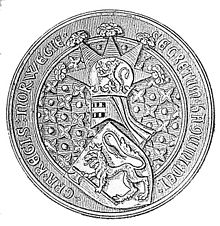Håkon V. (Norway)
Håkon V. (* 1270 in Tønsberg ; † May 8, 1319 ) was the second son of King Magnus VI. lagabætir and Ingeborg Eriksdatter from Denmark. He was a learned man and could even give speeches in Latin.
Formally he became duke in 1273, but he did not actually take over the office until 1284. On November 1, 1299, after the death of his older brother, he became King of Norway . He married Euphemia von Rügen and had the daughter Ingeborg and, with Gro Sigursdotter, the illegitimate daughter Agnes.
In 1302 he succeeded in changing the Act of Succession to the Throne in such a way that the legitimate sons of his daughter moved up to third place in the line of succession after any sons of his own. The marriage with his daughter thus became a political issue, and she was betrothed to different princes depending on the political considerations.
He built the fortresses Akershus , Vardøhus and Båhus . He saw his government task from a Christian perspective and built many pilgrim hospices on the pilgrimage to Nidaros . He supported the missionary work and saw that the workers got their wages. He furnished the churches well, especially St. Mary's Church in Oslo.
He carried out a major and radical administrative reform that shaped Norway into a state on the threshold of modern times. Role models from France and England were decisive, as was the anonymous Königsspiegel written shortly before his time .
With his death, the Sverre family died out in the male line. He was considered holy until the 16th century , and there was even an altar in the St. Mary's Church to worship him . Many miracles have been reported by him.
Individual evidence
- ^ R. Keyser and CR Unger: Barlaams og Josaphats saga . Christiania 1851. p. XIV fn. 2.
Web links
- Håkon 5 Magnusson (Norwegian)
| predecessor | Office | successor |
|---|---|---|
| Erik II |
King of Norway 1299-1319 |
Magnus VII |
| personal data | |
|---|---|
| SURNAME | Håkon V. |
| BRIEF DESCRIPTION | King of Norway |
| DATE OF BIRTH | 1270 |
| PLACE OF BIRTH | Tonsberg |
| DATE OF DEATH | May 8, 1319 |
